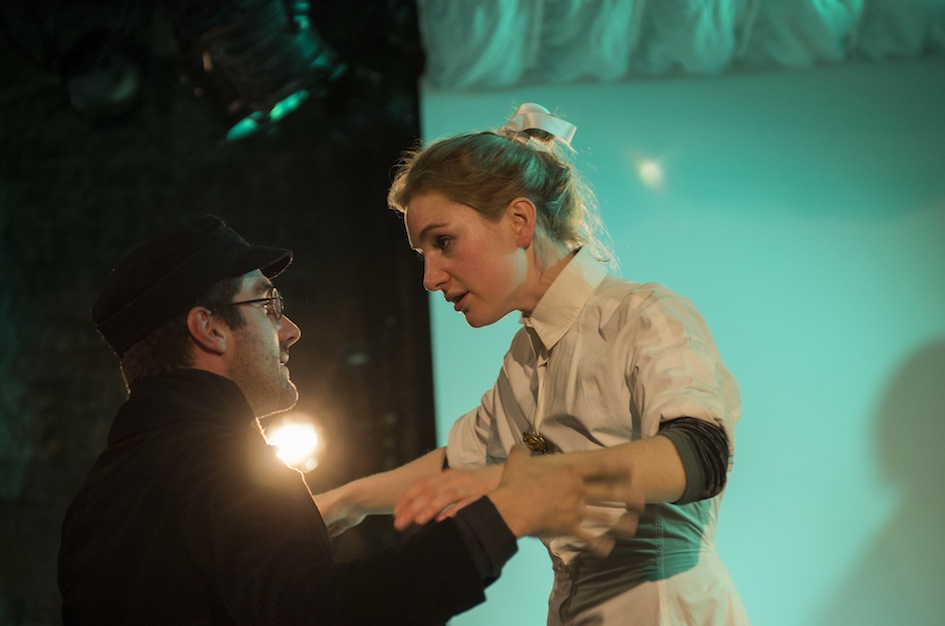A Tale of Two Cities, King's Head Theatre | reviews, news & interviews
A Tale of Two Cities, King's Head Theatre
A Tale of Two Cities, King's Head Theatre
An uneven staging of Terence Rattigan and John Gielgud's Dickensian adaptation

The opening of Charles Dickens's novel A Tale of Two Cities is among the most famous ever written: "It was the best of times, it was the worst of times, it was the age of wisdom, it was the age of foolishness…". If the publicity for this stage adaptation is to be believed, it is a scarcely less exalted addition to the mythology surrounding this novel.
It was written by Terence Rattigan and John Gielgud in 1935, when Rattigan was a young, unknown playwright with only a couple of professional credits to his name, while Gielgud was already renowned for his self-directed performances as Hamlet and Richard II at the Old Vic. The adaptation completed, a cast had been chosen and work had begun on the set when the whole enterprise was called off. The producer, Bronson Albery, decided to postpone it out of courtesy to Sir John Martin-Harvey, a venerable fixture of the London theatre scene who was currently playing Sidney Carton in a farewell tour of The Only Way, his own adaptation of Dickens's novel. Devastating as this news must have been for the young Rattigan, he apparently never went back to the script - which is how it comes to have its professional debut now, 78 years later.
There is a hint of madness and danger in his languid poses and fey gestures
All this makes for a thrilling little gobbet of theatrical history, but is it worth the wait? As director Adam Spreadbury-Maher admits in his introduction to the text, this is not quite the play that Rattigan and Gielgud intended. Theirs was to be a West End production, and the text they produced ran to some three and a half hours and required 40 actors. This version has been pared down for a company of just eight, and squeezed inside the intimate confines of a pub theatre.
The driving force behind Gielgud's wish to adapt the novel in the first place was his desire to play Sidney Carton, Dickens's dissolute central character who is moved by his unrequited love for the beautiful Lucie Manette to reform his ways and make the ultimate sacrifice to secure her happiness. This focus on Carton is apparent right from the start - the action of the play is curiously unengaging until he enters in the third scene, and the best of the play's dialogue goes to him. Newcomer Stewart Agnew puts in a superb performance as both Carton and the twisted French aristocrat, the Marquis St Evrémonde. As Carton, he is rakish and cynical, the bad boy lawyer clad all in leather, always with a glass of something in his hand. As the Marquis, there is a hint of madness and danger in his languid poses and fey gestures. With the exception of Paul Beech as the genial and honourable banker Jarvis Lorry, the rest of the cast doesn't quite measure up to Agnew's standard. The Gielgud/Rattigan adaptation attempts to transform Dickens's grand, sweeping novel about the human tragedy of the French Revolution into a domestic affair, focusing on the central love triangle and omitting (no doubt in part for technical reasons) the storming of the Bastille and the big Parisian street scenes. But aside from Carton's witty, doom-laden repartee, the domestic story feels flat and without interest. The great love story between Lucie Manette and Charles Darnay is suggested by little more than a few hand-clasps (as portrayed by Nicholas Bishop and Jennie Gruner, pictured above), and we are given little insight into the life of the Defarges, the play's other central family.
With the exception of Paul Beech as the genial and honourable banker Jarvis Lorry, the rest of the cast doesn't quite measure up to Agnew's standard. The Gielgud/Rattigan adaptation attempts to transform Dickens's grand, sweeping novel about the human tragedy of the French Revolution into a domestic affair, focusing on the central love triangle and omitting (no doubt in part for technical reasons) the storming of the Bastille and the big Parisian street scenes. But aside from Carton's witty, doom-laden repartee, the domestic story feels flat and without interest. The great love story between Lucie Manette and Charles Darnay is suggested by little more than a few hand-clasps (as portrayed by Nicholas Bishop and Jennie Gruner, pictured above), and we are given little insight into the life of the Defarges, the play's other central family.
Some of the production decisions, too, border on the absurd - the bizarre decision for the actors to use hand-held microphones during the Old Bailey scene produces an unpleasant effect in such a small theatre, and the incongruous use of songs like Amy Winehouse's "Rehab" between scenes ensures that the transformation of a pub's back room into the turmoil of revolutionary France never quite takes place.
- A Tale of Two Cities at the King's Head Theatre until 19 October
- Will Gompertz interviews director Adam Spreadbury-Maher on BBC Radio 4's Today programme
rating
Explore topics
Share this article
Add comment
The future of Arts Journalism
You can stop theartsdesk.com closing!
We urgently need financing to survive. Our fundraising drive has thus far raised £49,000 but we need to reach £100,000 or we will be forced to close. Please contribute here: https://gofund.me/c3f6033d
And if you can forward this information to anyone who might assist, we’d be grateful.

Subscribe to theartsdesk.com
Thank you for continuing to read our work on theartsdesk.com. For unlimited access to every article in its entirety, including our archive of more than 15,000 pieces, we're asking for £5 per month or £40 per year. We feel it's a very good deal, and hope you do too.
To take a subscription now simply click here.
And if you're looking for that extra gift for a friend or family member, why not treat them to a theartsdesk.com gift subscription?
more Theatre
 Othello, Theatre Royal, Haymarket review - a surprising mix of stateliness and ironic humour
David Harewood and Toby Jones at odds
Othello, Theatre Royal, Haymarket review - a surprising mix of stateliness and ironic humour
David Harewood and Toby Jones at odds
 Macbeth, RSC, Stratford review - Glaswegian gangs and ghoulies prove gripping
Sam Heughan's Macbeth cannot quite find a home in a mobster pub
Macbeth, RSC, Stratford review - Glaswegian gangs and ghoulies prove gripping
Sam Heughan's Macbeth cannot quite find a home in a mobster pub
 The Line of Beauty, Almeida Theatre review - the 80s revisited in theatrically ravishing form
Alan Hollinghurst novel is cunningly filleted, very finely acted
The Line of Beauty, Almeida Theatre review - the 80s revisited in theatrically ravishing form
Alan Hollinghurst novel is cunningly filleted, very finely acted
 Wendy & Peter Pan, Barbican Theatre review - mixed bag of panto and comic play, turned up to 11
The RSC adaptation is aimed at children, though all will thrill to its spectacle
Wendy & Peter Pan, Barbican Theatre review - mixed bag of panto and comic play, turned up to 11
The RSC adaptation is aimed at children, though all will thrill to its spectacle
 Hedda, Orange Tree Theatre review - a monument reimagined, perhaps even improved
Scandinavian masterpiece transplanted into a London reeling from the ravages of war
Hedda, Orange Tree Theatre review - a monument reimagined, perhaps even improved
Scandinavian masterpiece transplanted into a London reeling from the ravages of war
 The Assembled Parties, Hampstead review - a rarity, a well-made play delivered straight
Witty but poignant tribute to the strength of family ties as all around disintegrates
The Assembled Parties, Hampstead review - a rarity, a well-made play delivered straight
Witty but poignant tribute to the strength of family ties as all around disintegrates
 Mary Page Marlowe, Old Vic review - a starry portrait of a splintered life
Tracy Letts's Off Broadway play makes a shimmeringly powerful London debut
Mary Page Marlowe, Old Vic review - a starry portrait of a splintered life
Tracy Letts's Off Broadway play makes a shimmeringly powerful London debut
 Little Brother, Soho Theatre review - light, bright but emotionally true
This Verity Bargate Award-winning dramedy is entertaining as well as thought provoking
Little Brother, Soho Theatre review - light, bright but emotionally true
This Verity Bargate Award-winning dramedy is entertaining as well as thought provoking
 The Unbelievers, Royal Court Theatre - grimly compelling, powerfully performed
Nick Payne's new play is amongst his best
The Unbelievers, Royal Court Theatre - grimly compelling, powerfully performed
Nick Payne's new play is amongst his best
 The Maids, Donmar Warehouse review - vibrant cast lost in a spectacular-looking fever dream
Kip Williams revises Genet, with little gained in the update except eye-popping visuals
The Maids, Donmar Warehouse review - vibrant cast lost in a spectacular-looking fever dream
Kip Williams revises Genet, with little gained in the update except eye-popping visuals
 Ragdoll, Jermyn Street Theatre review - compelling and emotionally truthful
Katherine Moar returns with a Patty Hearst-inspired follow up to her debut hit 'Farm Hall'
Ragdoll, Jermyn Street Theatre review - compelling and emotionally truthful
Katherine Moar returns with a Patty Hearst-inspired follow up to her debut hit 'Farm Hall'
 Troilus and Cressida, Globe Theatre review - a 'problem play' with added problems
Raucous and carnivalesque, but also ugly and incomprehensible
Troilus and Cressida, Globe Theatre review - a 'problem play' with added problems
Raucous and carnivalesque, but also ugly and incomprehensible

Comments
Clearly went over Caroline's